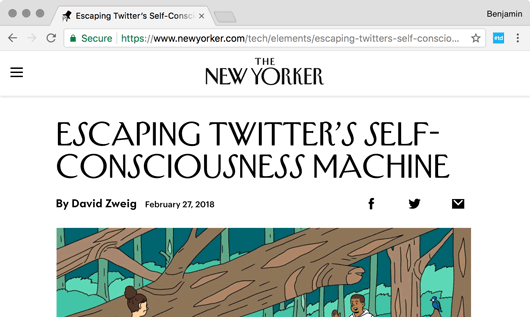My latest project, Twitter Demetricator, is a browser extension that removes all visible metrics from the Twitter interface. On the day of its release, the work was also the subject of a fantastic article in The New Yorker by author David Zweig. David spent a few weeks with the work as part of a private beta test, and then artfully reflected on his experience. I recommend you read the whole text, but here’s an excerpt:
After three weeks of using the Demetricator, the nature of Twitter, for me, changed completely. In some ways, it became lonelier. Part of the fun had been feeling like part of a crowd, seeing a joke or an idea or an observation become something that fifty people, or fifty thousand, could share. But I’m willing to accept the loss of this superficial sense of community for all the gains. Not seeing any numbers at all made content itself the king. I came to appreciate, disconcertingly, that knowing what was popular before had not only often distorted but also sometimes completely overtaken my experience. With the numbers gone, I realized that they, indeed, had forced a sort of automated experience, guiding and constraining my behavior.
The way that Twitter’s visible metrics were helping David feel “like part of a crowd” is one of my interests with this new Demetricator. While Twitter’s like, retweet, and follower metrics are similar—in principle—to Facebook’s like, share, and friend metrics, there’s definitely some important differences in how these metrics engineer user experience. On Facebook, likes/shares/etc are mostly constrained in size by one’s “friend” network, while on Twitter they are unconstrained. At any time, any Tweet’s metrics could reach not just into the hundreds of likes, but into the thousands or even millions. I’m guessing the sheer scale of this potential reaction activates our “desire for more” well beyond what users experience with Facebook. How does this expanded scale of potential reaction affect what David describes as a numbers-driven “automated experience” that guides and constrains behavior? That’s one of the questions I’ll be thinking about in the coming weeks.
Read about or install Twitter Demetricator, or go to the New Yorker and read David’s piece about it.
